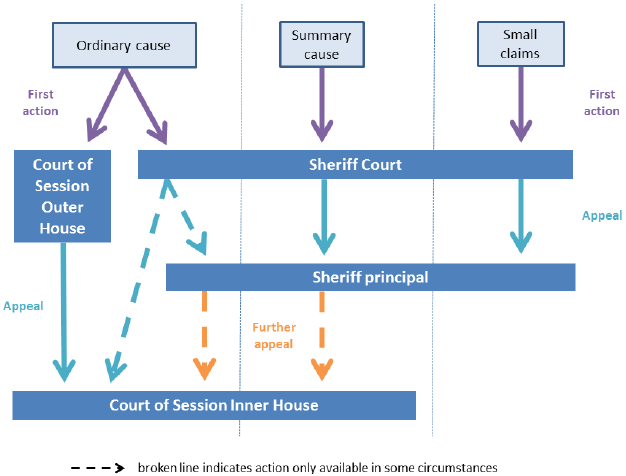Civil justice statistics in Scotland: 2012-2013
Civil law is concerned with the rights and obligations of people and organisations. One way of resolving civil law disputes between people and organisations is for a case to be brought to court. In Scotland civil law cases are usually conducted in a sheriff court or the Court of Session. Common types of cases where civil law is used include debt, divorce and claims for personal injury.
This document is part of a collection
7. Court of Session
The Court of Session is the highest civil court in Scotland. There are three departments within the Court of Session.
The General Department deals mainly with cases where one person wants to enforce a legal right against another. The General Department deals with a variety of case types including: personal injury, family, damages, interdict, intellectual property, debt and commercial.
The Petition Department deals with cases where the authority of the court is sought to deal with a variety of legal issues, other than disputes between people or organisations.
The Inner House and Extracts Department deals with all cases proceeding before the Inner House and the issue of official court documents allowing judgments of the court to be enforced, known as extracts.
Cases are heard either in the Outer House or the Inner House. The Outer House is where the majority of cases are first heard. In this court, single judges normally preside over cases. The Inner House deals primarily with appeals, although it does hear a small amount of first instance business. At least three judges sit to hear cases in this court, except where the business is procedural in nature when a single judge may sit for most classes of appeal.
Appeals from the Outer House of the Court of Session, known as reclaiming motions, are made to the Inner House. The Inner House also hears appeals from the sheriff courts and certain tribunals and other bodies.
Appeals against judgments of the Inner House of the Court of Session may be made to the Supreme Court of the United Kingdom, which was established on 1 October 2009 and replaced the House of Lords in its judicial function. A decision of the Inner House can be appealed to the UK Supreme Court. The general rule (with some exceptions) is that such appeals come to the UK Supreme Court without the requirement for permission by the Inner House but that they must be certified by two counsel as "reasonable" before they can be heard in the UK Supreme Court. Statistics on appeals from the Court of Session to the UK Supreme Court are not published by the Scottish Government.
Figure 2 displays the main relationships between civil law court procedures and the civil courts but it should be noted that there may be differences in certain circumstances. Summary applications and commissary business aren't represented in the diagram as the processes for dealing with these procedures vary depending on the subject matter of the case.
Figure 2: Summary of court structure

Contact
Email: Howard Hooper
There is a problem
Thanks for your feedback